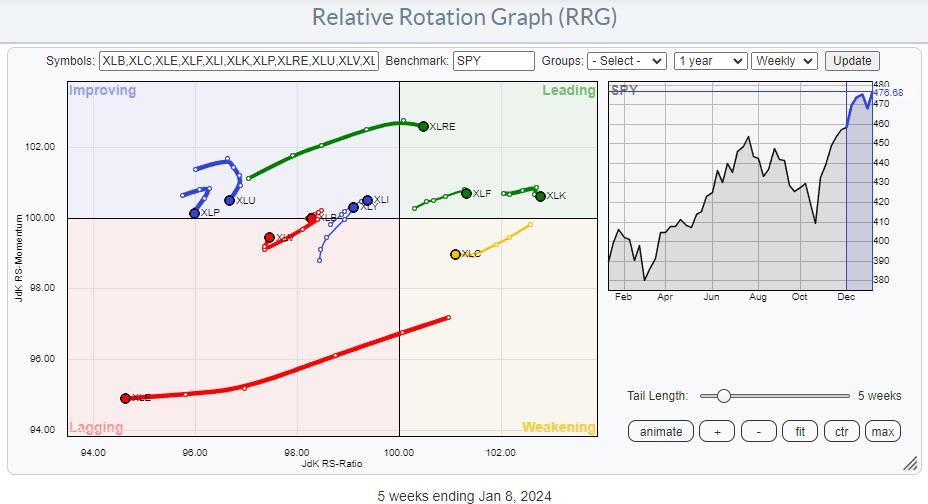
View The Large Cap – Small Cap Debate in a Direct Comparison on RRG
At the end of last year, I wrote a blog article about the relationship between Large-Cap and Equal-Weight sectors. It involved plotting the ratios of the Large-Cap sector ETFs against the Equal Weight sector ETFs.
You can find that article here in case you missed it.
Today, I want to expand that approach to the Large-Cap vs Small-Cap debate and bring the level of detail down to a direct comparison at sector level.
Large-Cap Rotation
Above is the most widely used Relative Rotation Graph for US sectors.
Observations from this RRG:
Energy rapidly losing relative strengthReal estate, Financials, and Technology remain strong inside the leading quadrant despite a slight loss of relative momentum.Communication Services leveling off on JdK RS-Momentum inside the weakening quadrant and possibly aligning up for a rotation back up to leading.Industrials and Consumer Discretionary continue to improve, slowly, inside the improving quadrant, but they are at a positive RRG-Heading (+)Materials is rotating back down and crossing over into laggingConsumer Staples and Utilities are turning back down toward the lagging quadrant while remaining at very low JdK RS-Ratio readings.Health Care is still inside the lagging quadrant but shows a sharp hook back up. It’s in its early stages, but improvement is there.
Small-Cap Rotation
This is the Small-Cap equivalent RRG.
Please note that Real-Estate is included in the Financials small-cap ETF; PSCF and Communication Services are included in Utilities.
To get a better handle on the rotations, I have switched off the long, disconnected tail for the energy sector (PSCE) in the graph below as it distorts the image.
The main observations from this RRG are:
Consumer Discretionary, Financials, and Materials are inside the leading quadrant, but only Materials is at a positive RRG-Heading. Discretionary and Financials have already started to lose relative momentum.The Industrials sector remains at an elevated RS-Ratio reading but has rotated into the weakening quadrant (temporarily?)Utilities exhibit a strong rotation from improving back to lagging and is potentially the weakest (small-cap) sector.Technology and Consumer Staples are both inside the lagging quadrant. Technology has shown substantial improvement over the last four weeks, while Consumer Staples only hooked back up sharply last week.Health care is the only sector improving, but the highest reading on the JdK RS-Momentum scale is promising.
By comparing these two Relative Rotation Graphs, you can already understand how rotations occur in these two universes.
However, both universes are plotted against their general benchmarks. Large-Cap is plotted against SPY, and the Small-Cap universe is plotted against $SML.
Large-Cap vs Small-Cap at Sector Level
To get a more granular reading on the relative performances of each large-cap sector vis-a-vis its small-cap counterpart, I created a universe of ratios where each symbol is the ratio of the large-cap sector to the small-cap sector.
*Click on the image to open a live RRG on the site. You can save it as a bookmark to your browser by clicking the permalink at the bottom of the page.
As the universe consists of ratio symbols, we need to adjust the benchmark to $ONE so the RRG will show us the absolute trends in these ratios.
It is immediately obvious that most of these tails are pointing/rotating toward or already inside the lagging quadrant.
Technology and Health care are still at decent levels in the weakening quadrant, providing them with enough room to turn back up without hitting the lagging quadrant. Utilities have made a first attempt to do that.
Inside the lagging quadrant, Consumer Discretionary is starting to pick up some relative momentum, but it is in its early stages.
All in all, this means that the rotation out of large-cap is taking place in almost all sectors. The only sector where investors should clearly prefer large-cap stocks is Energy, as the XLE:PSCE tail is pushing further into the leading quadrant.
#StayAlert, –Julius
